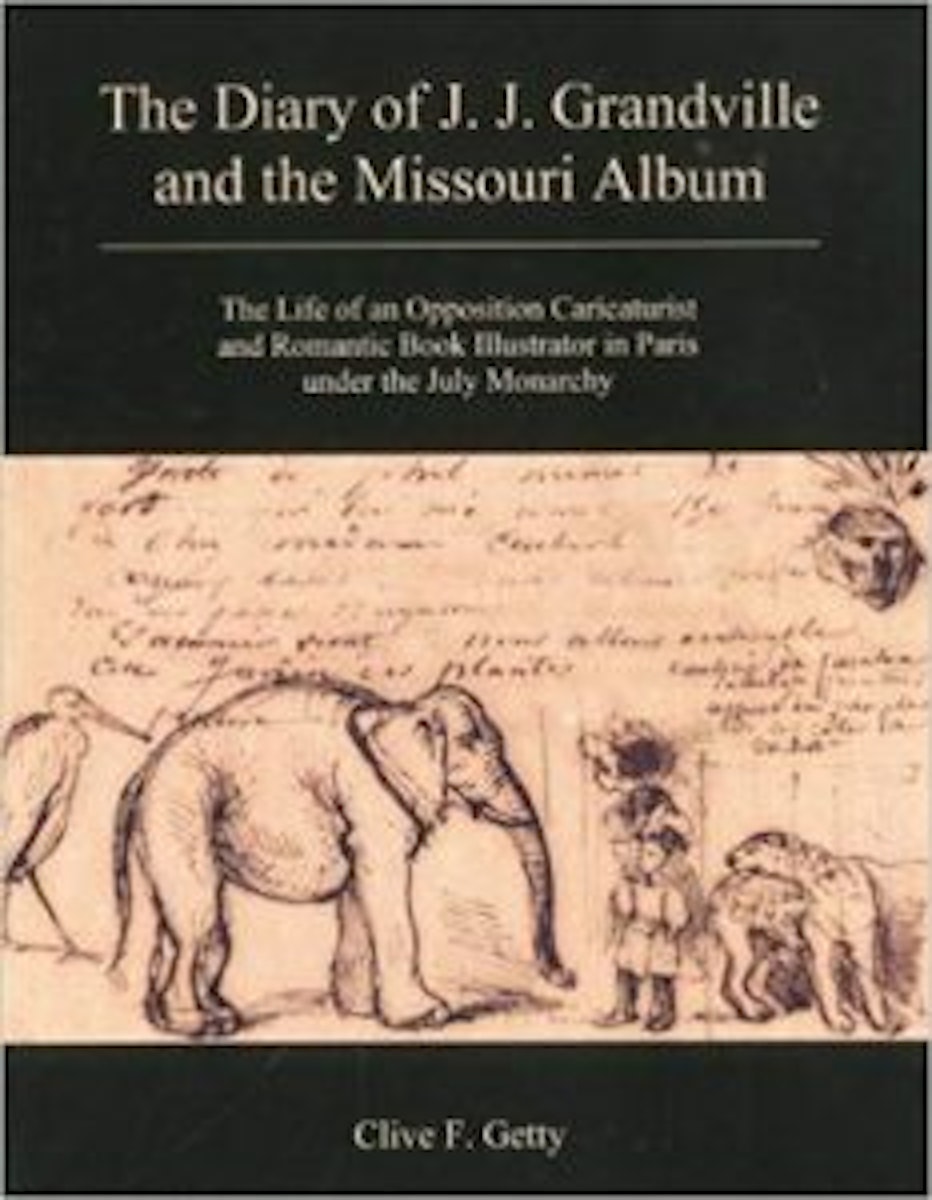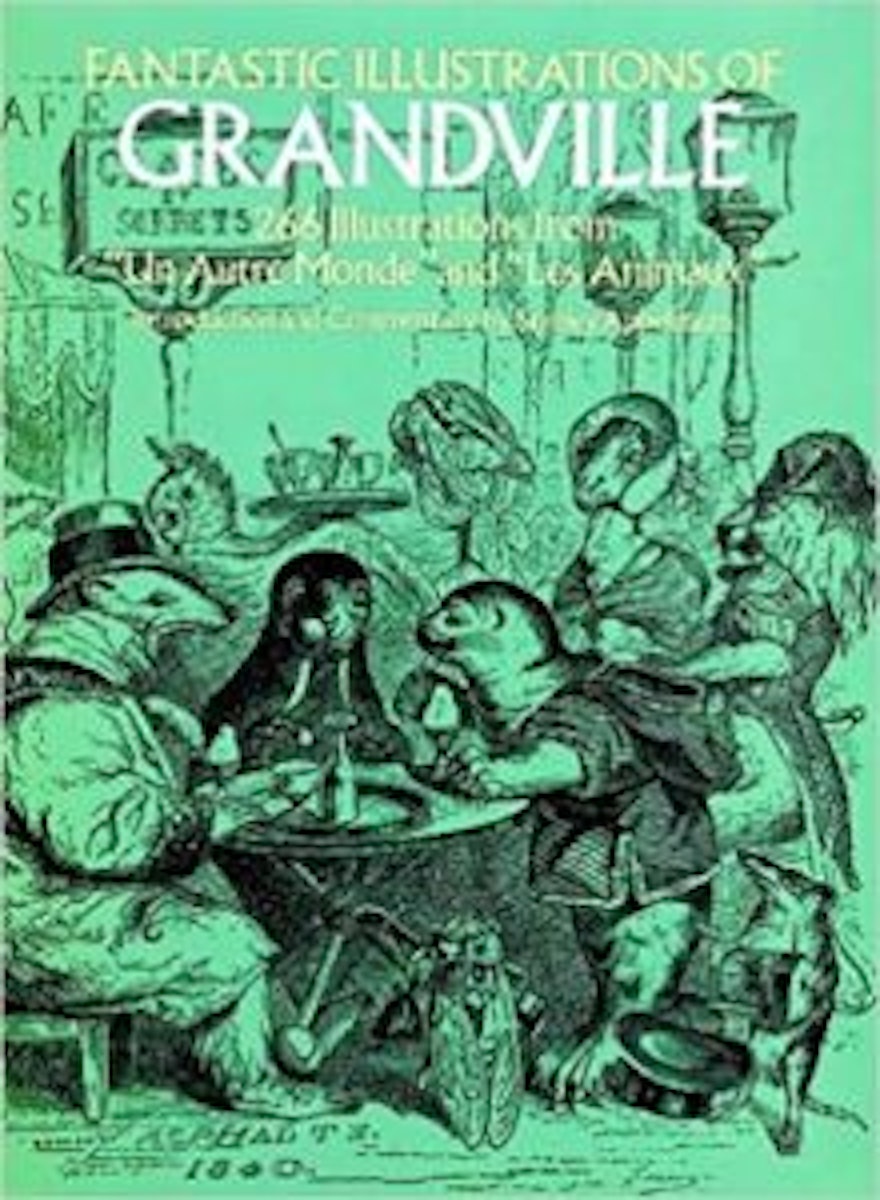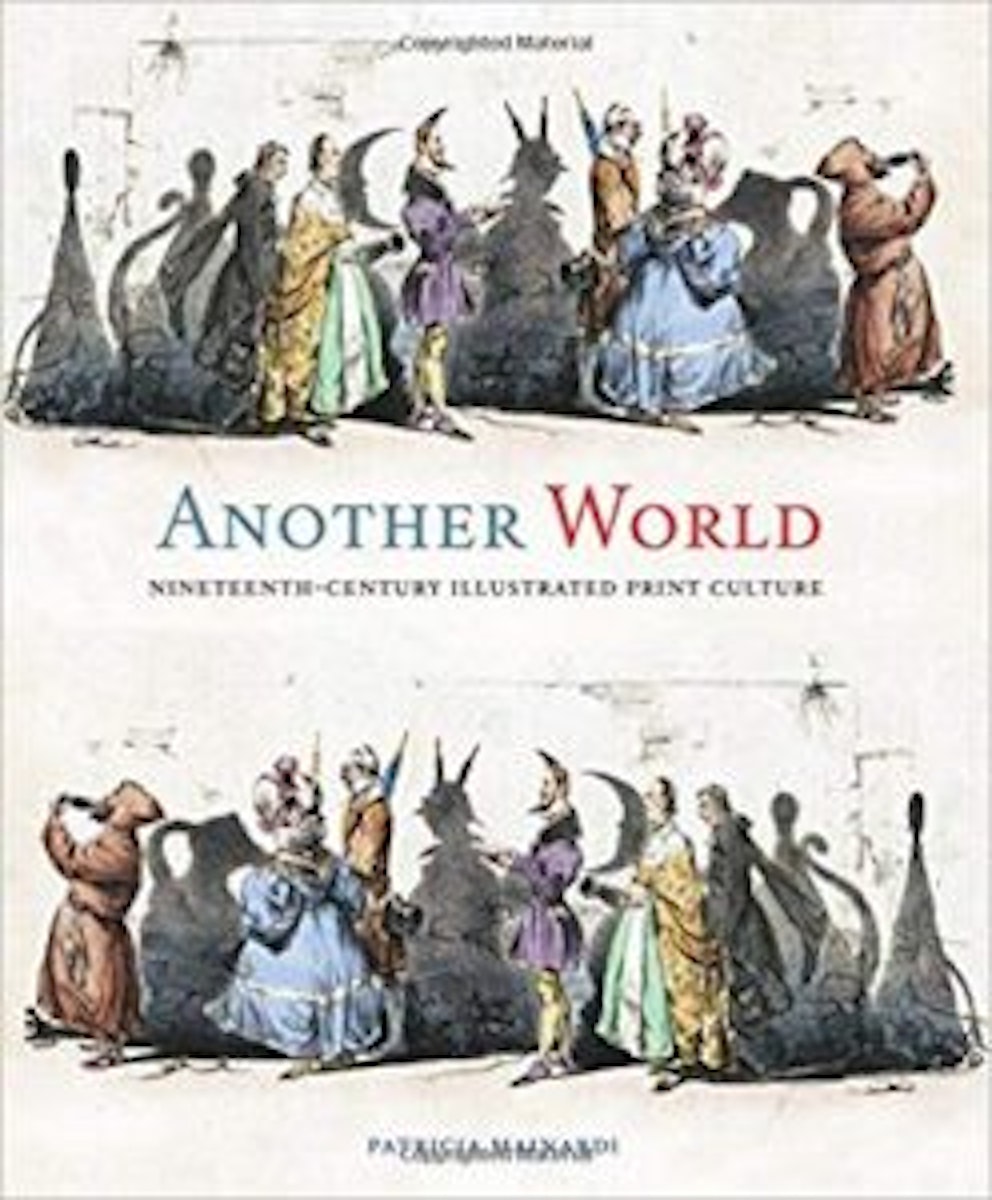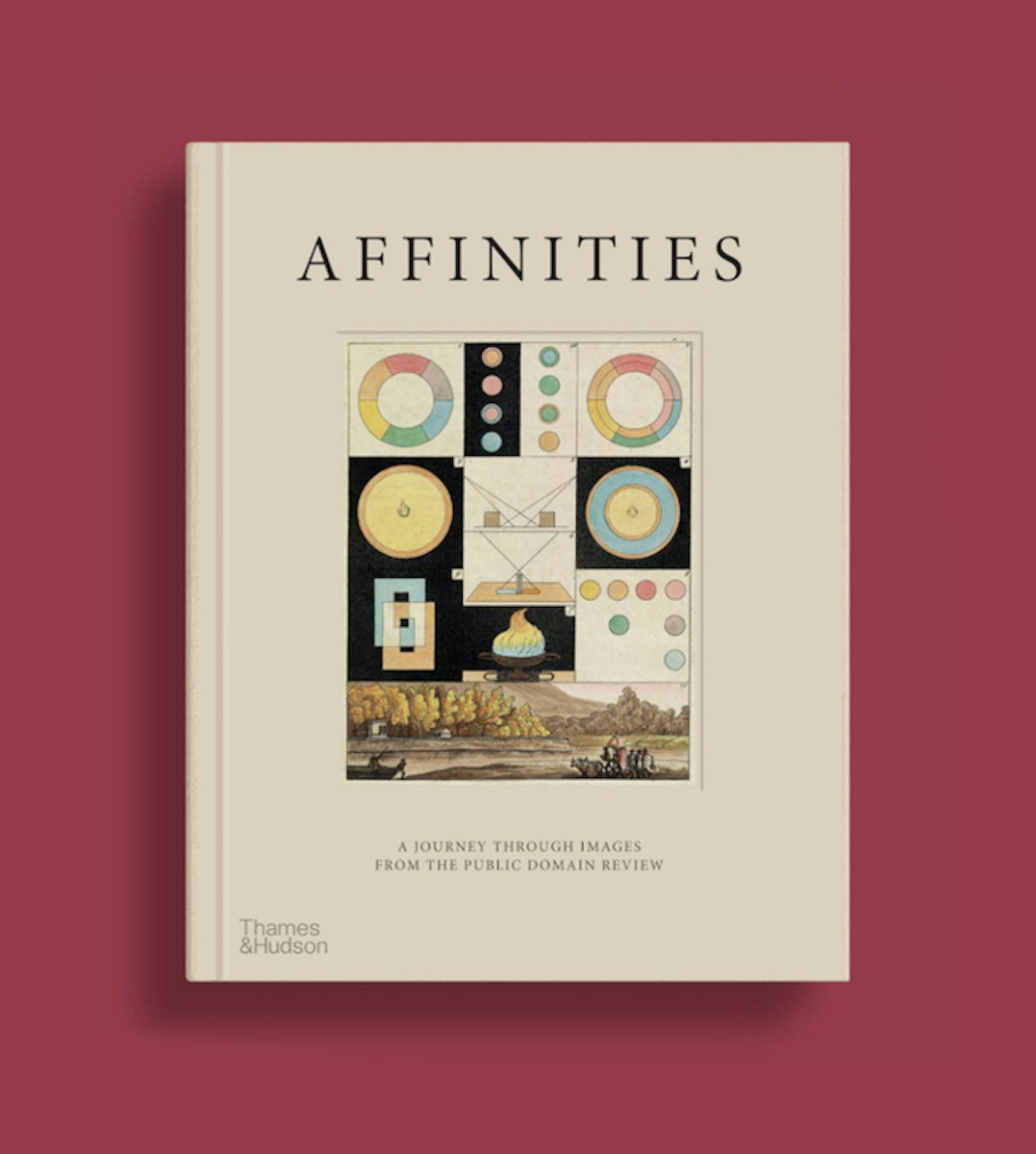
Grandville, Visions, and Dreams
With its dreamlike inversions and kaleidoscopic cast of anthropomorphic objects, animals, and plants, the world of French artist J. J. Grandville is at once both delightful and disquieting. Patricia Mainardi explores the unique work of this 19th-century illustrator now recognised as a major precursor and inspiration to the Surrealist movement.
September 26, 2018
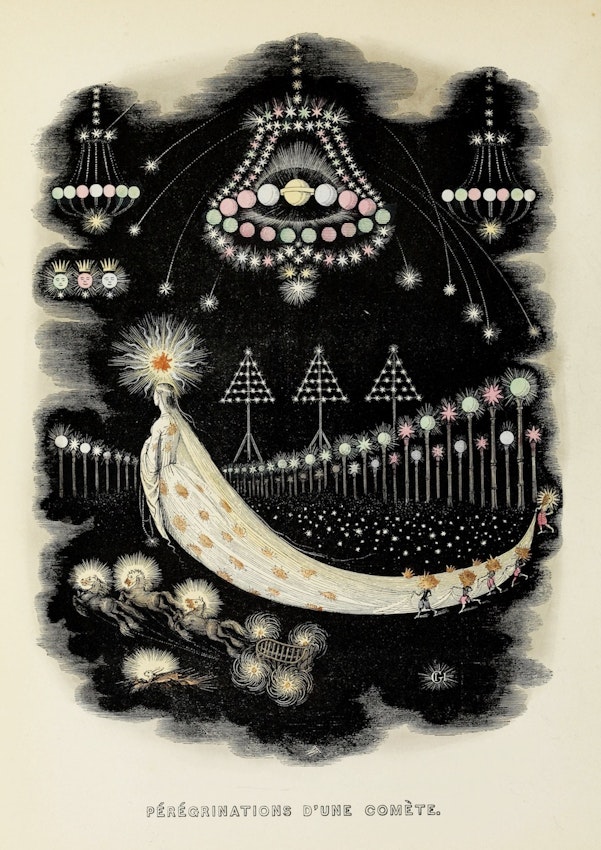 Scroll through the whole page to download all images before printing.
Scroll through the whole page to download all images before printing. The Wanderings of a Comet, from Another World, 1844 — Source.
[Available to buy as a print]
The poet Charles Baudelaire greatly admired the graphic arts, writing several essays about the major caricaturists and illustrators of his day. He found something positive to say about each of them with one exception, the artist Jean-Ignace-Isidore Gérard, known simply as Grandville (1803–1847). And yet, despite Baudelaire’s antipathy, Grandville is arguably the most imaginative graphic artist of the nineteenth century, as well as the most influential on subsequent generations. Baudelaire was well aware of Grandville’s gifts, but his aversion was that of a true classicist:
There are superficial people whom Grandville amuses, but as for me, he frightens me. When I enter into Grandville’s work, I feel a certain discomfort, like in an apartment where disorder is systematically organized, where bizarre cornices rest on the floor, where paintings seem distorted by an optic lens, where objects are deformed by being shoved together at odd angles, where furniture has its feet in the air, and where drawers push in instead of pulling out.1
Baudelaire’s comments were perceptive: these are the very characteristics that, while making him uncomfortable, appealed to the next century’s surrealist artists and writers who saw in Grandville a kindred spirit who shared their interest in the uncanny, in the dream state, and in the world of imagination.
Grandville died young, at forty-three, but in his short life his work ranged across the entire spectrum of graphic art, from political caricature to book illustration. His early drawing Let’s Put Out the Light and Rekindle the Fire! for the journal La Silhouette displays the eerie quality many found so disturbing: the censors are drawn with bellows for heads and one large eye, looking very like birds of prey as they go about their grim business of book-burning under cover of darkness. Behind them other censors resembling candle-snuffers in clerical garb join in, all working to extinguish the lumière, the Enlightenment.
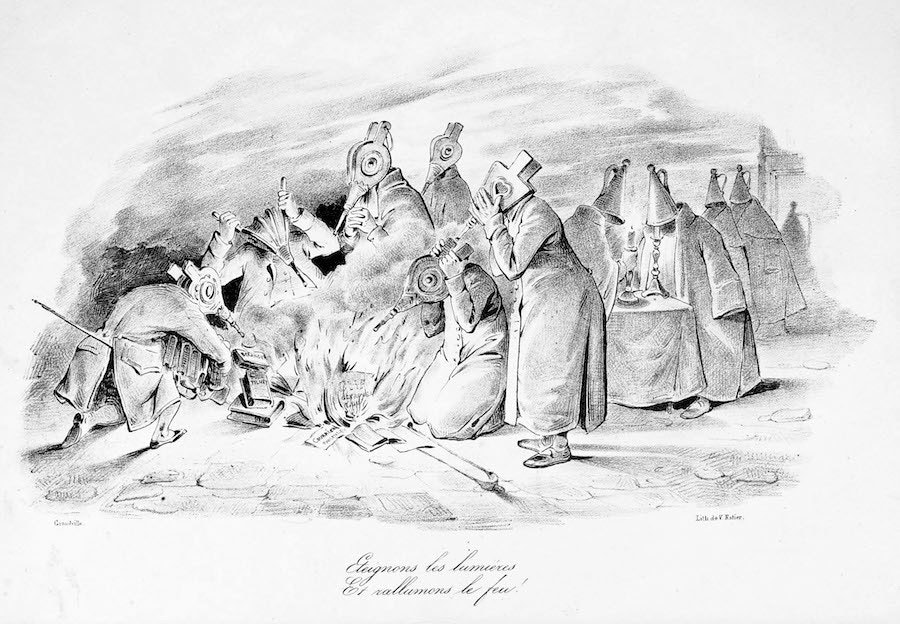 Scroll through the whole page to download all images before printing.
Scroll through the whole page to download all images before printing.Let’s Put Out the Light and Rekindle the Fire!, from La Silhouette, June 24, 1830 — Source: author’s scan.
The image proved so biting that it was proscribed, although by then it had already been published. In 1835, however, political caricature ground to a halt when the government instituted a new series of draconian censorship laws calling for prior (not post) publication censorship. Grandville then devoted himself to book illustration and to the world of imagination. Nonetheless, an enigmatic work such as An Animal in the Moon drawn for the 1838 edition of the Fables of La Fontaine is no less strange than his earlier political drawings — perhaps even more so since it lacks clear referents. Why is the disembodied hand holding a rat upside down by the tail? What is the meaning of the discarded scientific instruments, one of which has a human head? Nothing here is rational; it is, as Baudelaire said, disorder systematically organized. Grandville would, no doubt, agree; he described his creative process as such: “I don’t invent, — I just juxtapose dissimilar things and interweave discordant and incongruous forms.”2
 Scroll through the whole page to download all images before printing.
Scroll through the whole page to download all images before printing.An Animal in the Moon, from Fables de La Fontaine, Book VII, No. 18, 1838 — Source: author’s scan.
During Grandville’s lifetime his best-known works were those in which animals played human roles, delighting audiences both superficial (pace Baudelaire) and sophisticated, who relished the analogies between his personae and the animal avatars assigned to them. Do we really need a lengthy exegesis of the consummate bourgeois holding the rent bill in The Private and Public Lives of Animals?
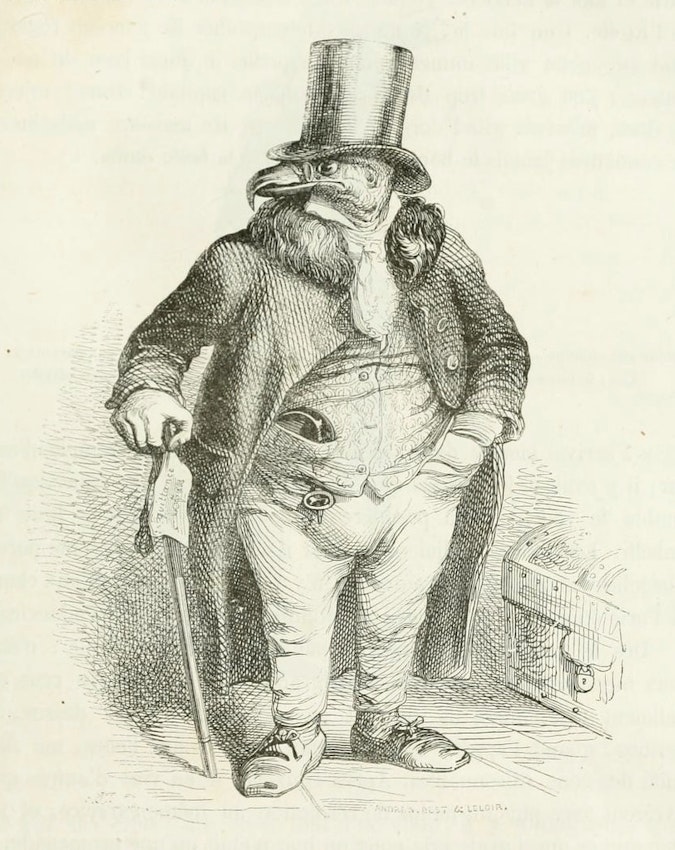 Scroll through the whole page to download all images before printing.
Scroll through the whole page to download all images before printing.Mister Vulture, from a 1867 edition of Scenes from the Private and Public Lives of Animals — Source.
Mister Vulture indeed! Grandville’s least controversial work has always been his most popular; his posthumously published Flowers Personified, a series of lovely female figures metamorphosed into blooms, for example, has remained in print well into its second century. Like Mister Vulture it needs no interpretation.
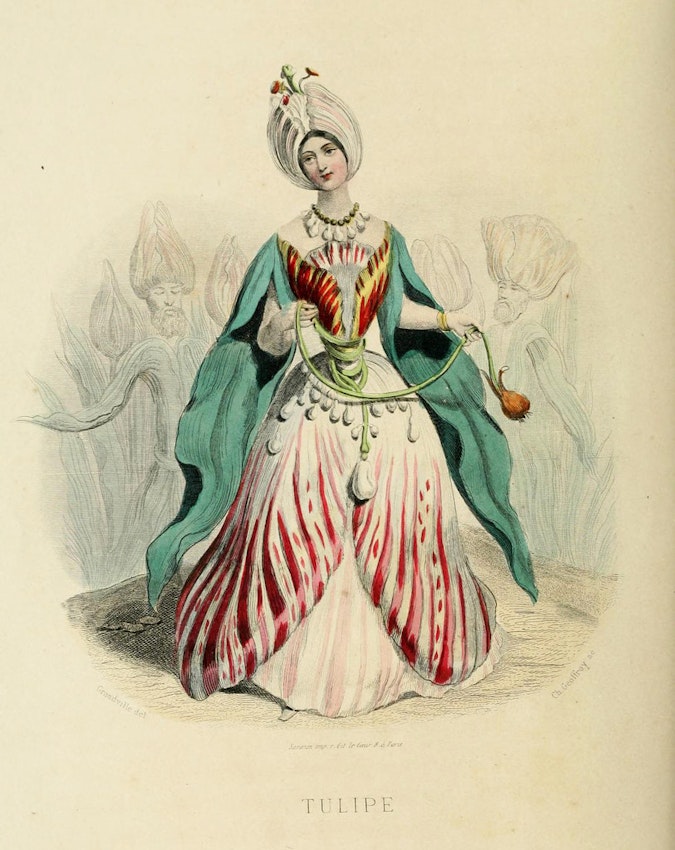 Scroll through the whole page to download all images before printing.
Scroll through the whole page to download all images before printing.Tulip, from Flowers Personified, 1847 — Source.
There is a reason for this. The work of a graphic artist was always collaborative, undertaken at the behest of a publisher. Graphic artists worked mostly on commission; paid by the piece, they considered themselves fortunate if contracted to produce all the drawings for one of the richly illustrated editions that were so popular with nineteenth-century audiences. The standard procedure was that the artist provided the drawing, which would then be translated into an incised wood engraving, printed and hand-colored by specialists. Grandville did his share of these commissioned works, producing illustrations for Don Quixote, Gulliver’s Travels, and Robinson Crusoe, among others, but because of this expensive and time-consuming production process, graphic artists were rarely allowed to follow their own inclinations. Nonetheless, Grandville’s most inventive work did just that, departing from the conventional understanding of illustration as subservient to text; Grandville’s drawings stand alone.
When the contemporaneous critic Charles-François Farcy tried to explain the different types of graphic design, he set forth a hierarchy of qualities.3 The lowest level — and always the most popular — was amusement directed at someone’s physical appearance; slightly more elevated was the pleasure offered by the visualization of a depicted situation. But the highest of all was work that broached philosophical or moral questions. Grandville, he judged, fell into this highest category, the philosophical. This quality might explain the disjunction between Grandville’s works that were most popular with his contemporaries and his work that appealed to future generations of artists. He forged a lifetime friendship with Edouard Charton, the editor of Le magasin pittoresque, the first French illustrated periodical, who allowed him to draw whatever he wished. In 1840, Grandville produced a series of musical scores for Le magasin where the notes were personified: Waltz, Military Music, Religious Music, etc., and each was “staffed” by appropriately costumed and performing figures. In Waltz, an interracial couple dances through several lines of music before collapsing, exhausted, in the last bar.
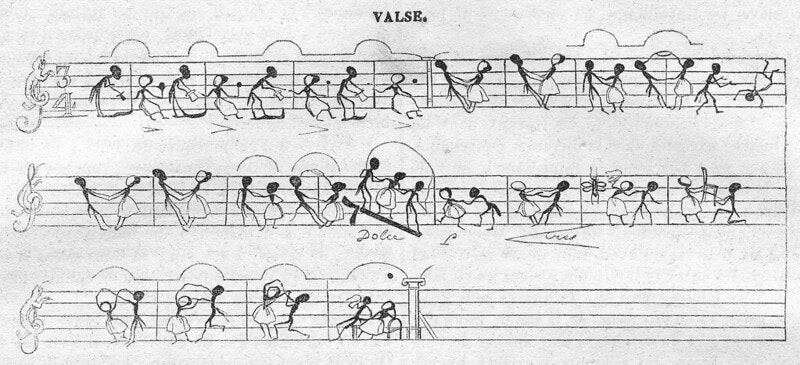 Scroll through the whole page to download all images before printing.
Scroll through the whole page to download all images before printing.Waltz from Le Magasin pittoresque, August 1840 — Source.
His 1844 Man Descending towards the Brute was a send-up of the contemporaneous interest in evolution — Charles Darwin’s Voyage of the Beagle had been published five years earlier. Here age most definitely does not beget wisdom: a young boy “devolves” from the classical physiognomy of youth into a low-browed, slack-jawed ape. In Portraits Compared a prince turns into a frog, the opposite trajectory of fairy-tales. In both projects, Grandville interrogates conventional thinking in drawings that have no need of explanatory text.
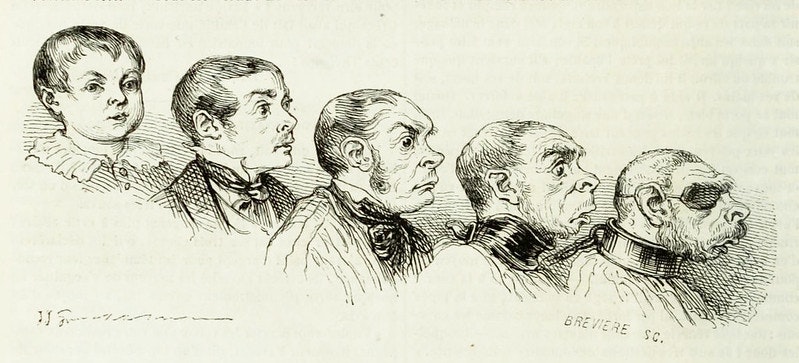 Scroll through the whole page to download all images before printing.
Scroll through the whole page to download all images before printing.Man Descending towards the Brute, from Le Magasin pittoresque, April 1843 — Source.
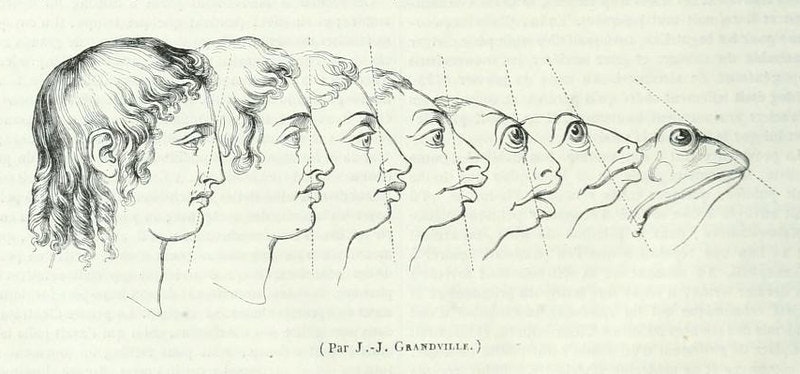 Scroll through the whole page to download all images before printing.
Scroll through the whole page to download all images before printing.Portraits Compared, from Le Magasin pittoresque, August 1844 — Source.
In his last letter to Charton, written only weeks before his death, Grandville mused about the drawings he was sending along for publication: “. . . what should be our title? The Metamorphoses of Sleep? Transformations, Deformations, Reformations of Dreams? Sequence of Ideas in Dreams, Nightmares, Reveries, Raptures, etc? or rather Harmonic Transformations of Sleep? But here I think is the true title: Nocturnal Visions and Transformations.”4 And that is what he depicts in A Promenade through the Sky, the languid progression of imagery that passes through our consciousness as it recedes slowly from our quotidian reality into the private world of imagination and fantasy. A mushroom becomes a parasol, which becomes an owl, and gradually the progression of images diminishes into a chariot pulling the horses of night into the stars. . . which taper off in brilliance as consciousness dims into sleep. He returned to this theme often as a kind of visual stream of consciousness where one image dissolves into another. In The Metamorphosis of Sleep, a bird becomes cupid’s arrows, eventually a flower in a vase, then a lovely woman, who gradually fades into a garland of flowers that dissolves into a snake slithering away. Freud’s Interpretation of Dreams wasn’t published until 1899, but surely the good doctor would have had much to say about these images.
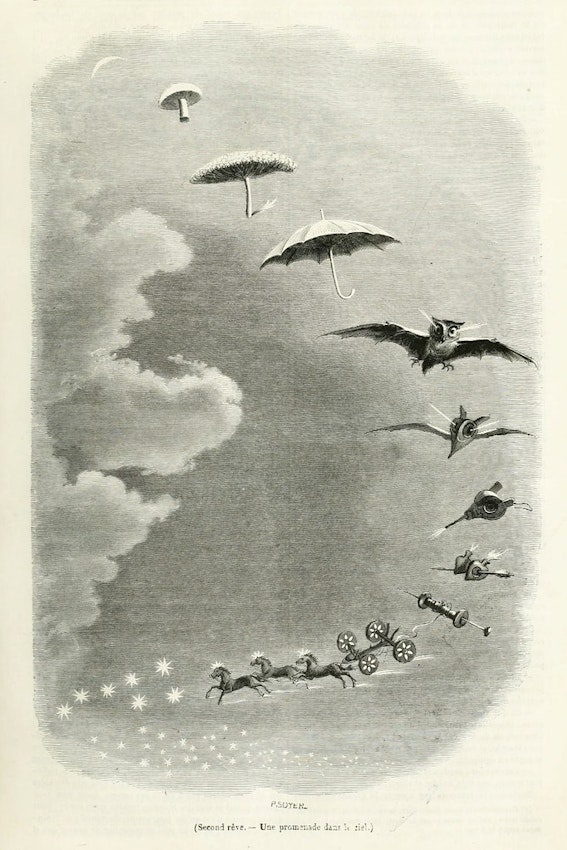 Scroll through the whole page to download all images before printing.
Scroll through the whole page to download all images before printing.A Promenade through the Sky, from Le Magasin pittoresque, June 1847 — Source.
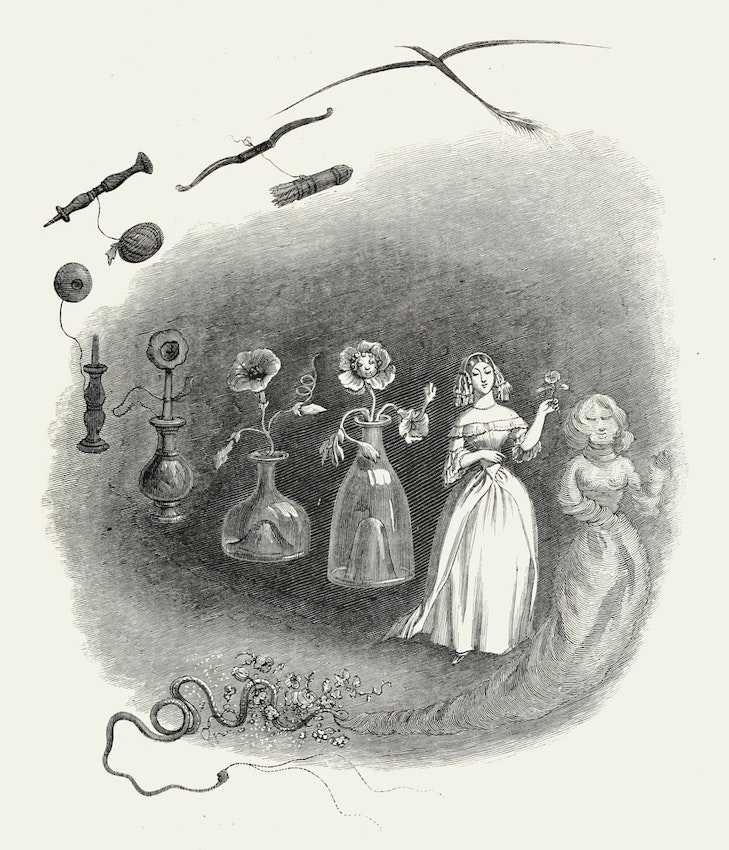 Scroll through the whole page to download all images before printing.
Scroll through the whole page to download all images before printing.The Metamorphosis of Sleep, from Another World, 1844 — Source.
Of all Grandville’s projects, the one most influential in its afterlife was least successful during his own lifetime, his 1844 Another World. Grandville wanted to produce it himself in its entirety, but he did not write easily. “The pen rebels in my hands at forming sentences”, he explained.5 Although he did produce brief illustrated texts for Le Magasin pittoresque, a full-length novel seemed well beyond his abilities, and so Another World was written by Taxile Delord, the editor of the journal Le Charivari to which Grandville had contributed numerous drawings. In Another World’s introductory dialogue between the personifications of the Pen (the Writer) and the Crayon (the Artist), the Crayon demands “You will allow my wings to move freely through space; you will not impede in any way my flight towards the new spheres that I wish to explore.”6 The Pen responds humbly: “So you want me to serve purely and simply as a secretary?” — to which the Crayon answers, “Precisely”.7 The contract for Another World specified that the novel would be written according to Grandville’s notes, and Delord’s position as a mere scribe is indicated by his name appearing only on the book’s last page, while Grandville’s is prominently displayed on its cover.
The loosely organized plot offers a series of barely related adventures of its three protagonists, Dr Puff, a down on his luck con man who conceives the idea of founding the new religion of Neo-Paganism along with two cronies: Krackq, a seaman whose business card identifies him as “Professor of Swimming”, and Hahblle, a former choirmaster and unsuccessful composer whose desire to revolutionize the musical scale by recognizing the philosophical importance of the note of sol (G) was no more successful than his major symphonic work, The I and the Non-I. Together they decide to explore the universe in order to sell their stories to a publisher. These anti-heroes discover Another World; in fact, they discover several other worlds, each a thinly-veiled satire on our own. The full title of the work bears witness to its extreme departure from contemporaneous literary norms: Another World: Transformations, Visions, Incarnations, Ascensions, Locomotions, Explorations, Peregrinations, Excursions, Vacations, Caprices, Cosmogonies, Reveries, Whimsies, Phantasmagorias, Apotheoses, Zoomorphoses, Lithomorphoses, Metamorphoses, Metempsychoses, and Other Things. The book’s thirty-four chapters amply deliver on this extravagant promise.
The novel’s minimal narrative functions principally as a framework for Grandville’s drawings — thirty-six full-page hand-colored wood engravings and one hundred forty-six wood-engraved vignettes, smaller images inserted into a page of text. This feature distinguishes Another World from earlier visionary and satirical works such as Jonathan Swift’s Gulliver’s Travels or Rabelais’ Gargantua and Pantagruel, making Another World more like a graphic novel than an illustrated text. Each chapter can best be described as posing the question “what if. . .?” What if social status was clearly indicated by stature? In the chapter “The Great and the Small” Puff discovers a world where the idle rich are very tall, while the laboring classes are short. What if, instead of the European gaze objectifying “the other,” the tables were turned? In this reversal, Chinese Shadows (the French term for Shadow Play) becomes French Shadows, and the power dynamics of the gaze are reversed, with the Chinese audience enjoying the spectacle of French performers.
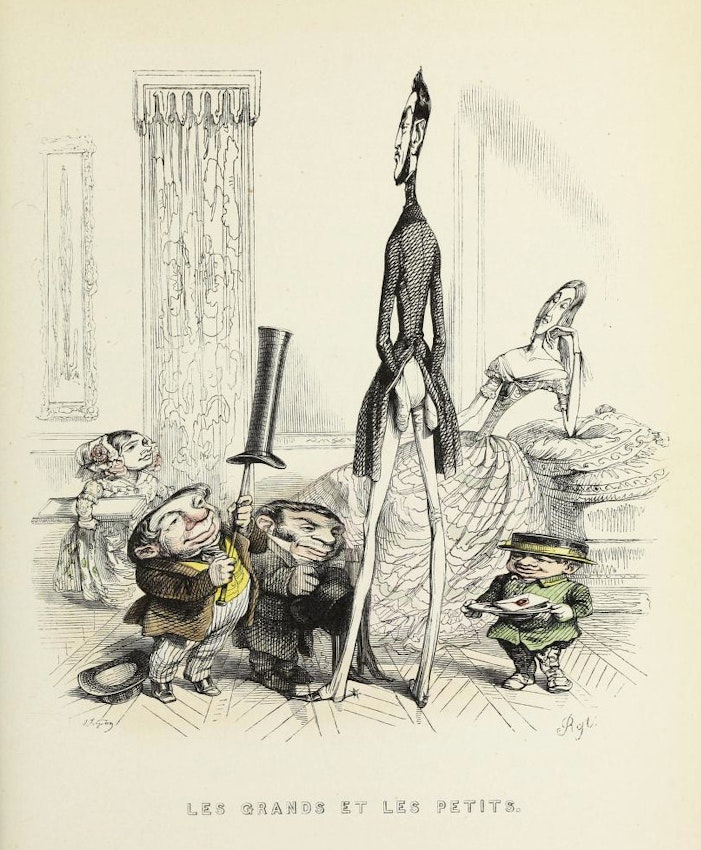 Scroll through the whole page to download all images before printing.
Scroll through the whole page to download all images before printing.The Great and the Small, from Another World, 1844 — Source.
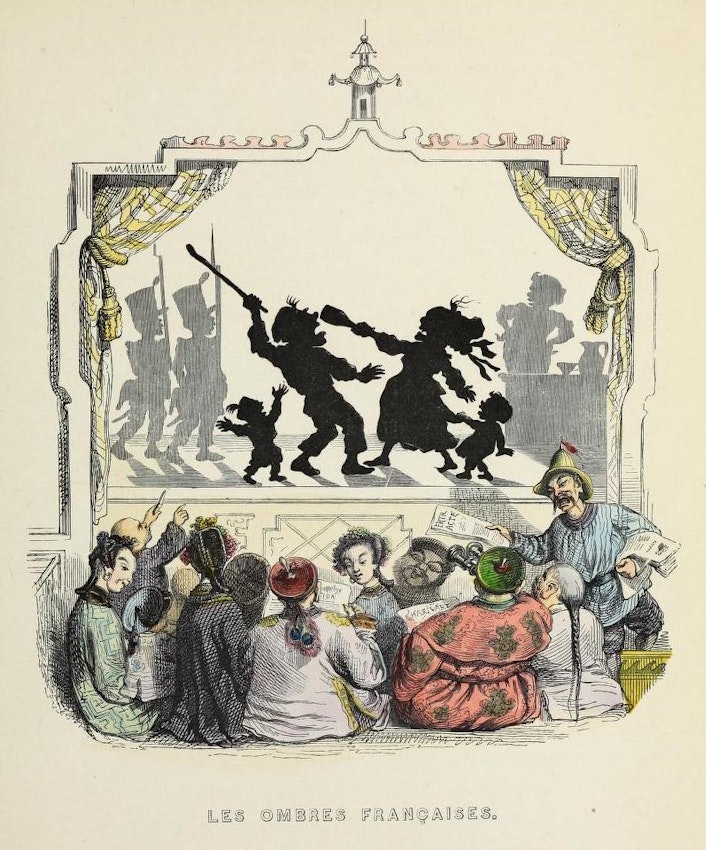 Scroll through the whole page to download all images before printing.
Scroll through the whole page to download all images before printing.French Shadows, from Another World, 1844 — Source.
Role reversals were a standard aspect of traditional world-upside-down imagery dating back centuries, featuring pictures of yoked men pulling carts, schoolboys beating their teacher, men caring for babies, etc. Such images served to reinforce the status quo by demonstrating the sheer absurdity of alternatives, but Grandville’s images do the opposite. They depict alternatives that, instead, demonstrate the absurdity of the status quo and serve to undermine it.
While it would be a stretch to consider Grandville a feminist, several of his drawings for Another World explore permutations of gender. In Apocalypse at the Ballet a female dancer becomes disembodied legs, a mechanical spinning top, while the audience is represented by clapping hands that expand, become large and grasping, and then metamorphose into crab claws, then clappers, wine bottles, wine glasses, an hourglass. The shaving brush directly above the clapping hands indicates that the entire progression is a male fantasy. From above, a shower of coins, wreaths, and cupid’s arrows rains down, perhaps the fantasies of the ballerina?
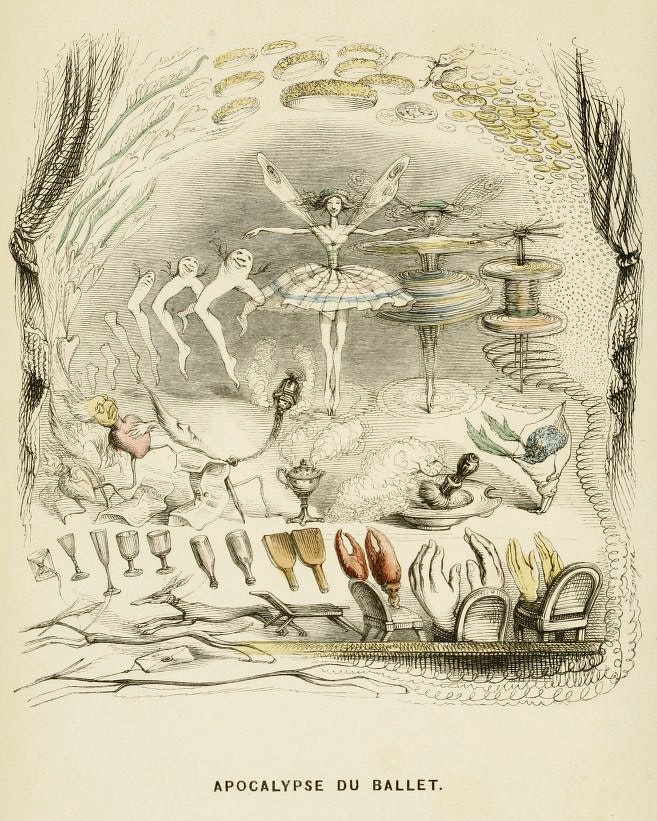 Scroll through the whole page to download all images before printing.
Scroll through the whole page to download all images before printing.Apocalypse at the Ballet, from Another World, 1844 — Source.
The theme of gender is treated more forcefully in It’s Venus in person! which captures incisively the predicament of an unaccompanied woman subject to the male gaze, represented here as large eyeballs on male torsos. This is the same phenomenon of active seeing and passive objectification that is the subject of French Shadows, for who better than an artist to comprehend the power of the gaze?
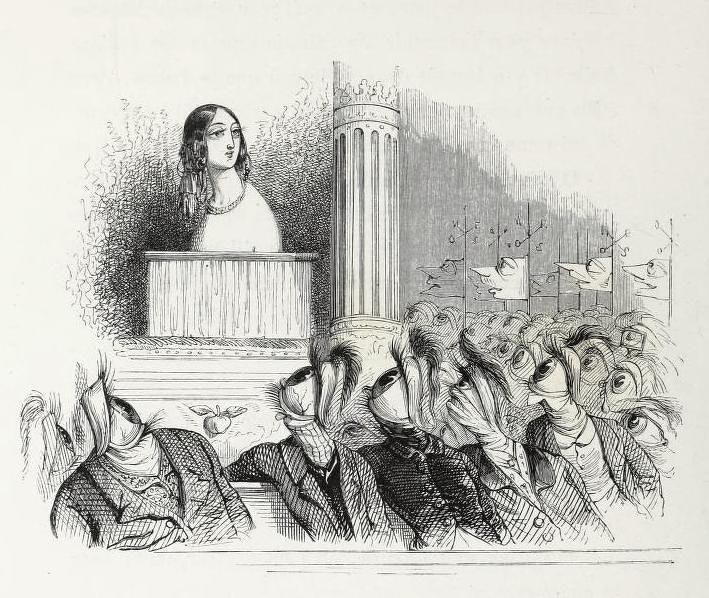 Scroll through the whole page to download all images before printing.
Scroll through the whole page to download all images before printing.It’s Venus in Person! from Another World, 1844 — Source.
But gender roles don’t affect only women. What if both men and women were free to follow their inclinations? Puff visits a country where this is a reality and sees a man dressed in brightly colored stockings and fur muff, while women carry walking sticks and smoke pipes and cigars. Confused, as transvestism was outlawed in France, he consults a conservative newspaper that violently, although apparently ineffectively, fulminates against this practice by asserting that “They are trying to overturn the stability of dress and proclaim the promiscuity of clothing”, concluding “The sexes will never lose the distinctive appearance that differentiates them.”8 But in Another World, they already have.
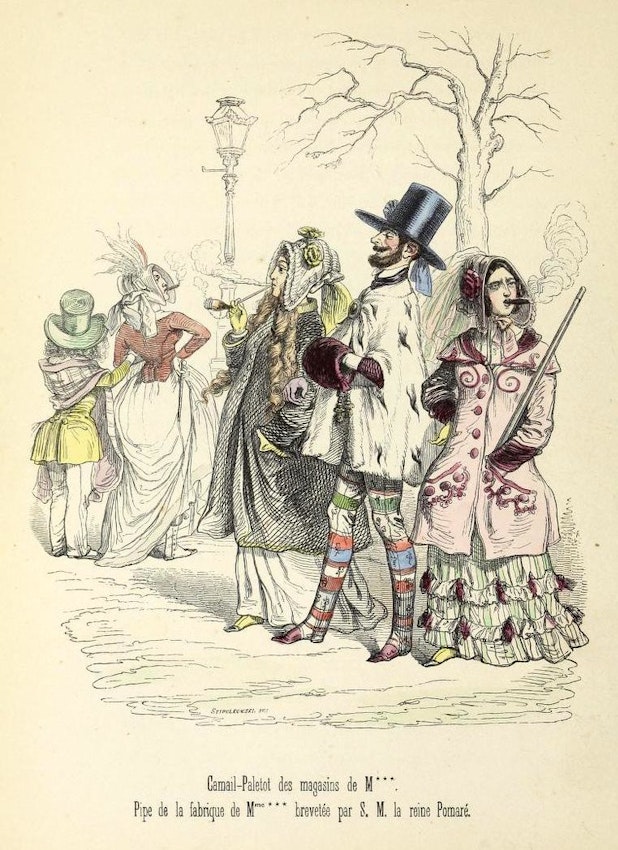 Scroll through the whole page to download all images before printing.
Scroll through the whole page to download all images before printing.Hooded coat from the shop of M*** Pipe manufactured by Mme*** patented by Her Majesty the Queen Pomaré, from Another World, 1844 — Source.
Grandville’s sympathy is not limited only to humans and animals, however; if sentient beings have rights, why not vegetables too? In the chapter “A Revolution in the World of Plants”, they rise up in revolt: “You, vegetables, hard-working and fertile race, will you allow them to rip away your offspring at the most tender age so they can devour them as early produce? . . . . Hear the cries of victims who demand vengeance from the bottom of the frying pan.”9 Combat of Two Refined Creatures shows the resultant civil war, here featuring the sugar beet in combat with the sugar cane.
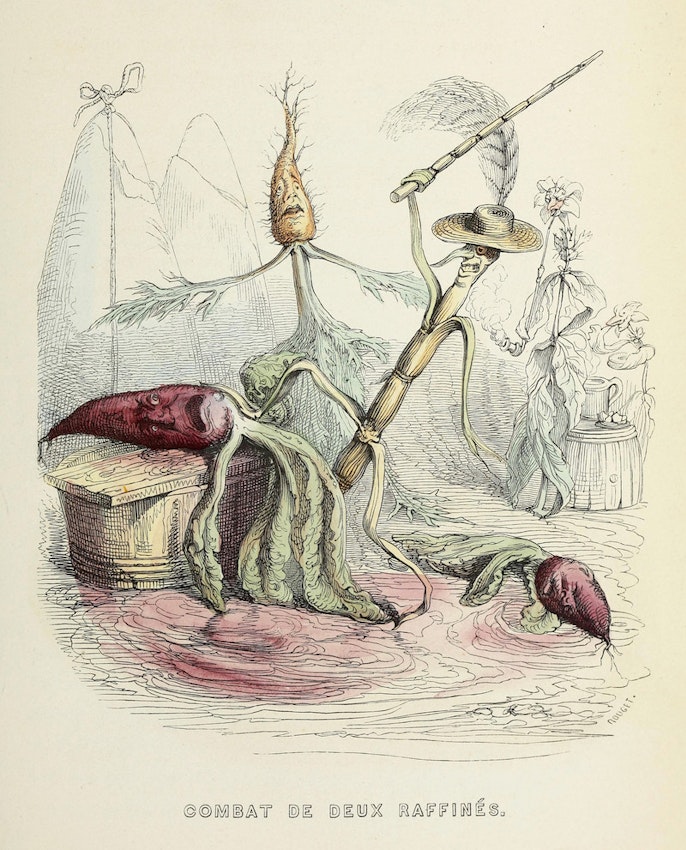 Scroll through the whole page to download all images before printing.
Scroll through the whole page to download all images before printing.Combat of Two Refined Creatures, from Another World, 1844 — Source.
Sadly, small degrees of distinction affect even the vegetable kingdom. Even lowly playing cards have the same character flaws, prone to settling their disputes with violence. Battle of the Playing Cards inspired Lewis Carroll’s Alice’s Adventures in Wonderland and probably ranks as Grandville’s most familiar image to twenty-first-century audiences.
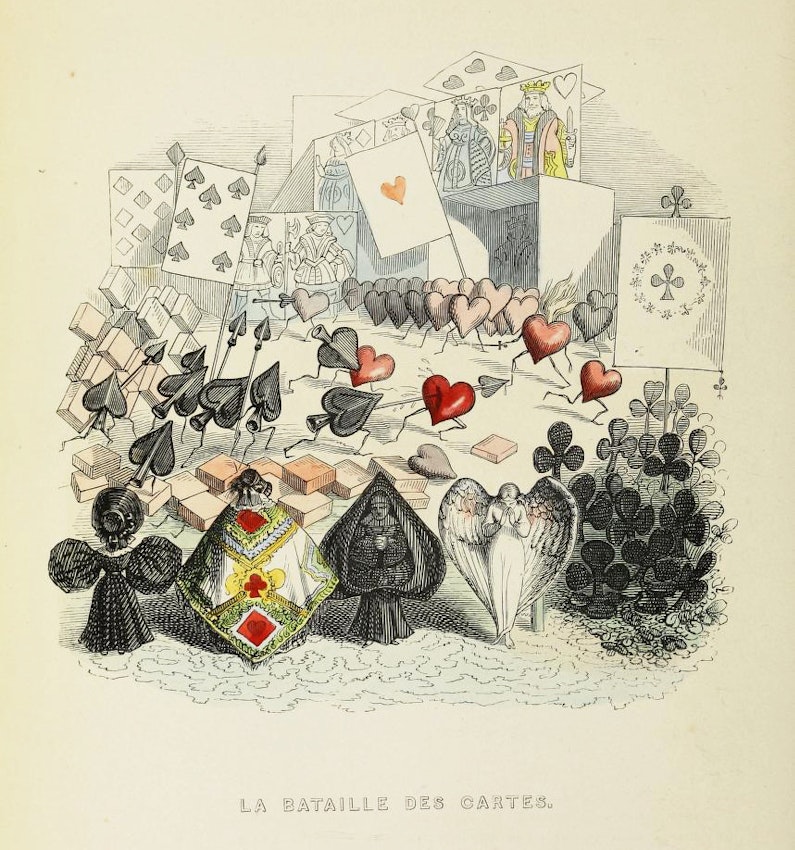 Scroll through the whole page to download all images before printing.
Scroll through the whole page to download all images before printing.Battle of the Playing Cards, from Another World, 1844. Hand-Colored Wood-Engraving — Source.
Grandville not only undermines our preconceptions and expands our perceptions of our own world, but he also underscores the limitations of our banal human consciousness in the face of the miraculous. By representing the phenomenon of an eclipse as the embrace of the sun and the moon he proposes Another World of consciousness. The prosaic and rational audience is represented here by mechanical scientific instruments that are completely oblivious to the poetry of the event they are witnessing, seeking only to measure and quantify it. But what if we could comprehend our place in the universe as merely one world among many? We know other planets exist, so why can’t we build bridges to connect them?.
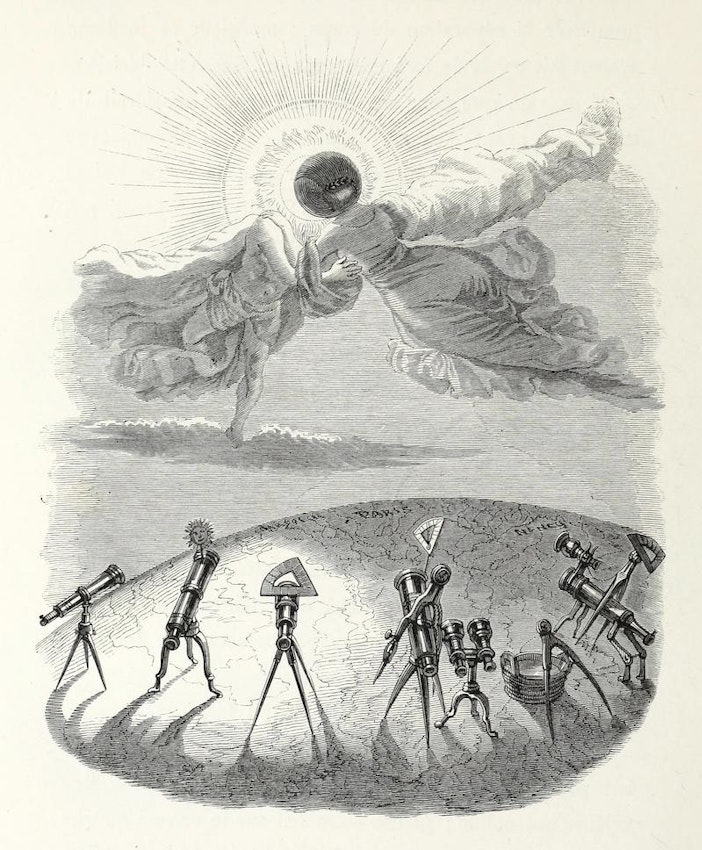 Scroll through the whole page to download all images before printing.
Scroll through the whole page to download all images before printing. A Conjugal Eclipse, from Another World, 1844 — Source.
[Available to buy as a print]
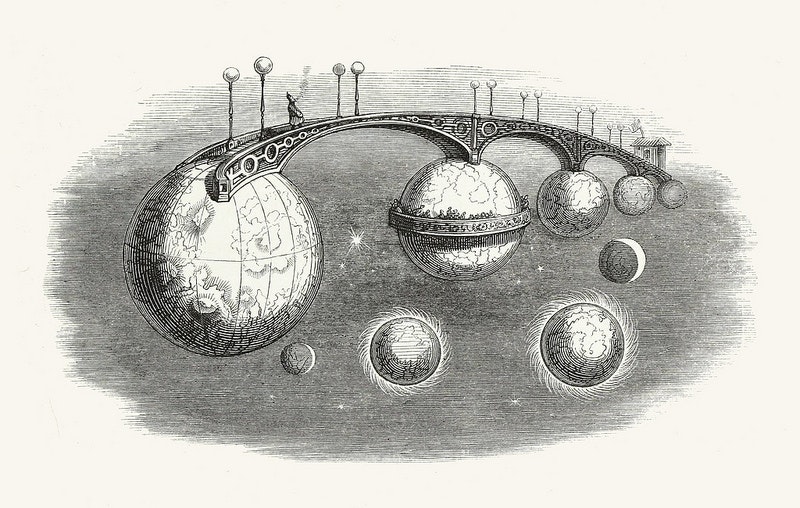 Scroll through the whole page to download all images before printing.
Scroll through the whole page to download all images before printing. A Bridge Leads from One World to the Next, from Another World, 1844 — Source.
[Available to buy as a print]
In one of his best-known drawings, he demonstrates our planetary insignificance, at the mercy of a celestial juggler who amuses himself by playing with unknown worlds. “As flies to wanton boys are we to th’ gods”, Shakespeare’s King Lear lamented several centuries earlier. In The Juggler, Grandville creates a haunting image of this fate.
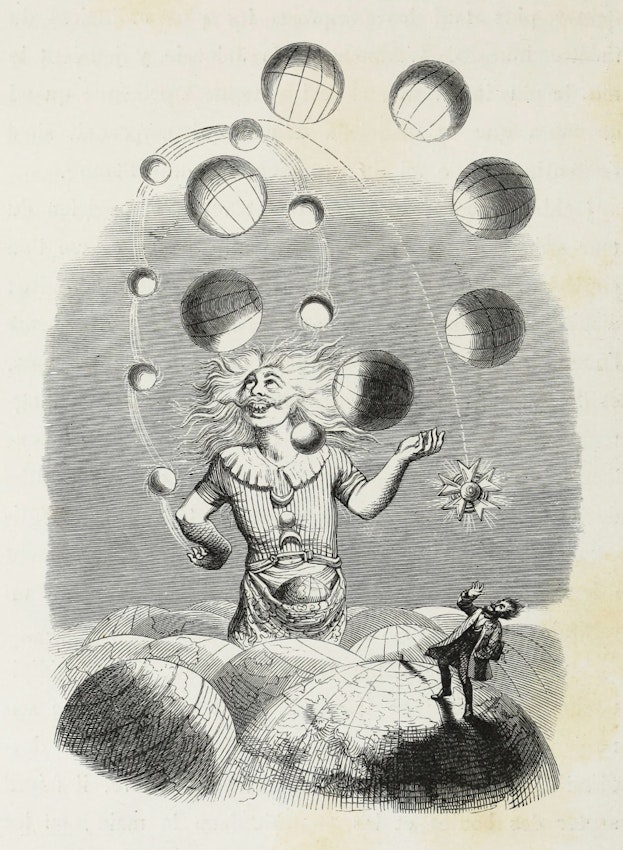 Scroll through the whole page to download all images before printing.
Scroll through the whole page to download all images before printing.The Juggler, from Another World, 1844 — Source.
The philosopher Walter Benjamin was fascinated by Grandville’s art, although he asserted, incorrectly, that Grandville had died insane. In his essay “Paris, Capital of the Nineteenth Century”, he identified Grandville with the phantasmagoria of the modern world, especially its burgeoning commodity culture.10 Grandville certainly was aware of this phantasmagoria, showing fashionable mannequins literally composed of their apparel — fine boots, cane and top hat for men, parasol and chapeau for women. “Why do we even need the rest of the person?” Puff the huckster asks.11
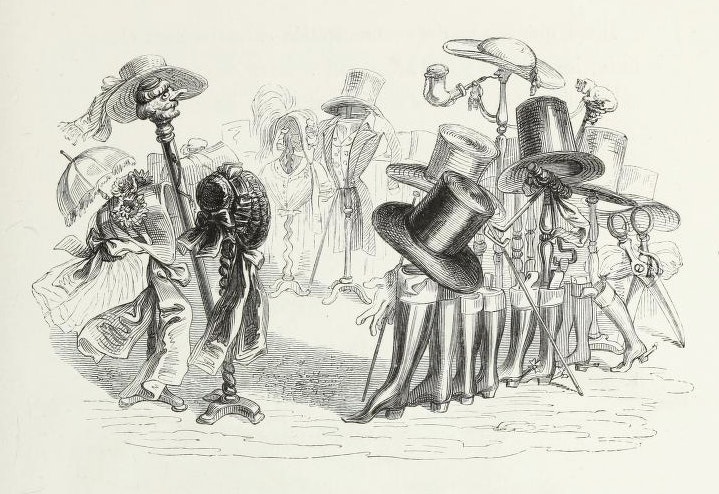 Scroll through the whole page to download all images before printing.
Scroll through the whole page to download all images before printing.Illustration from Another World, 1844 — Source.
Some of Grandville’s most insightful work in Another World treats this theme: Competition shows men attempting to climb the ladder of success, brandishing self-promotional flyers while lashing out at those who might overtake them. He represents Fashion as a goddess seated at an eternal spinning wheel of styles, but Grandville isn’t referring here to clothing styles alone. Puff the cynic prophesies that eventually all things will be subsumed to fashion: “Once we define glory as worldly success, then naturally we must assign art to the realm of fashion.”12 In the context of Grandville’s ruthless attacks on commodity culture, Benjamin’s critique of him as its epigone seems to miss his point.
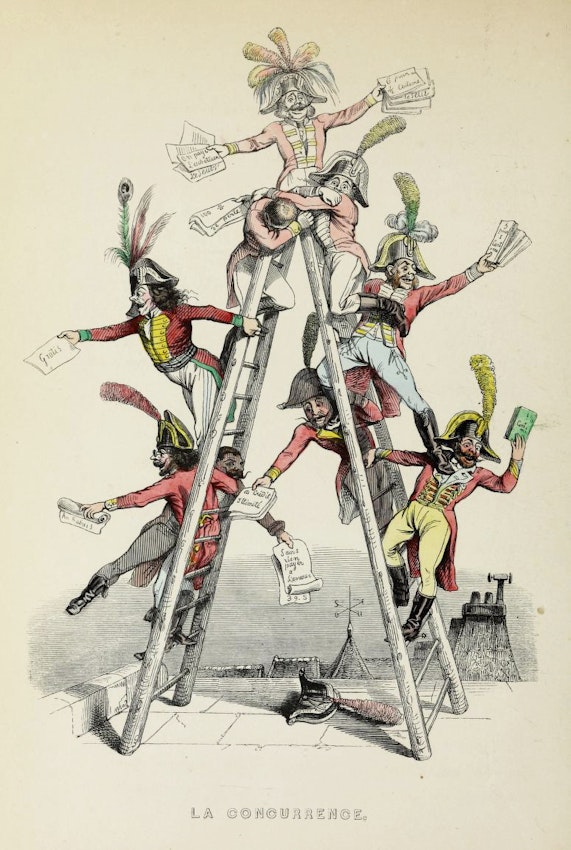 Scroll through the whole page to download all images before printing.
Scroll through the whole page to download all images before printing.Competition, from Another World, 1844 — Source.
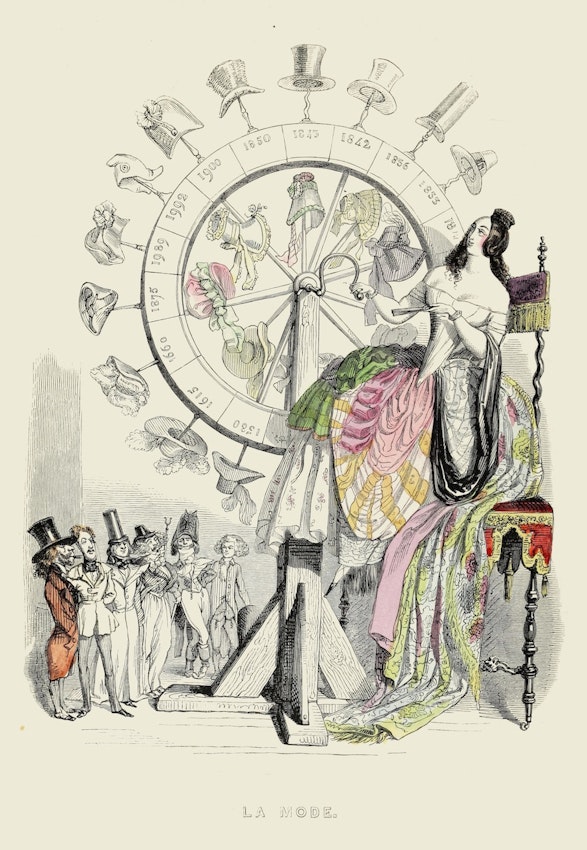 Scroll through the whole page to download all images before printing.
Scroll through the whole page to download all images before printing. Fashion, from Another World, 1844 — Source.
[Available to buy as a print]
Grandville was well aware that Another World did not achieve the success he had hoped for. In his last letter to Charton, three years after its publication, he wrote: “Until now, I believe, no work of art has understood and expressed dreams (except Another World, a recent and little-known work by your humble servant).”13 He was correct on both counts: it was unique and it was ignored. When Théophile Gautier wrote his obituary that same year, he lavished praise on The Public and Private Lives of Animals as Grandville’s “true masterpiece” but didn’t even mention Another World.14 It was published in only one edition, never translated into other languages, and never reappeared in his own century. No matter. In 1963 a facsimile edition was published, and the noted surrealist Max Ernst provided a frontispiece for it with the legend, “A new world is born. All praise to Grandville.”15
Patricia Mainardi is Professor Emeritus in the Doctoral Program in Art History at the City University of New York. She has published numerous books, articles and exhibition catalogues on nineteenth-century art, including Another World: Nineteenth-Century Illustrated Print Culture (Yale University Press, 2017).
Imagery from this post is featured in
Affinities
our special book of images created to celebrate 10 years of The Public Domain Review.
500+ images – 368 pages
Large format – Hardcover with inset image





